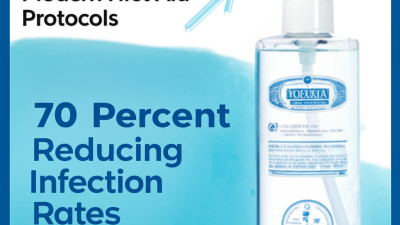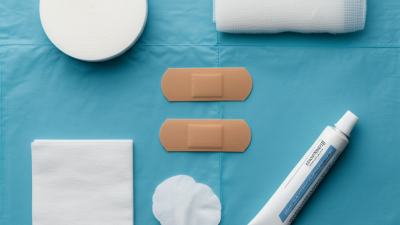The Essential Role of Wound Cleanser in Modern First Aid Protocols with 70 Percent Reducing Infection Rates
In the realm of modern first aid, the importance of Wound Cleanser cannot be overstated, as it plays a crucial role in preventing infections and promoting healing. According to a study published in the Journal of Clinical Medicine, utilizing an effective wound cleanser has been shown to reduce infection rates by up to 70%, significantly improving patient outcomes.

The World Health Organization highlights that improper wound management can lead to severe complications, including sepsis and prolonged healing times, making the integration of high-quality wound cleansing products into emergency care protocols essential. Furthermore, a report from the American Academy of Orthopaedic Surgeons indicates that nearly 30% of surgical site infections could be avoided with adequate wound cleansing practices.
As such, incorporating a reliable Wound Cleanser into first aid strategies is not just beneficial but essential for ensuring optimal care and reducing clinical risks associated with contaminated wounds.
The Impact of Wound Cleansers on Infection Prevention in First Aid
Wound cleansers play a pivotal role in modern first aid protocols, particularly in preventing infections. The initial step in treating any wound is to ensure cleanliness, as contaminated wounds are prone to bacterial growth, which can lead to severe complications. Recent studies indicate that utilizing wound cleansers can reduce infection rates by up to 70 percent. This significant decrease in infection risk underlines the importance of incorporating effective cleansing agents into first aid kits, empowering responders to take immediate action in various situations.
The impact of wound cleansers extends beyond merely preventing infections; they also contribute to faster healing times and improved overall outcomes. Antimicrobial formulations found in many wound cleansers help eliminate harmful pathogens while preserving the integrity of healthy skin. By using a wound cleanser, first responders not only address the immediate concerns of dirt and debris but also actively mitigate the risk of infection. Such practices demonstrate the evolving landscape of first aid, where scientific advancements are integrated into everyday protocols, enhancing patient care in urgent and emergency scenarios.
The Essential Role of Wound Cleanser in Infection Prevention
This chart illustrates the impact of various wound cleansers on infection rates in first aid settings. The data shows how different cleansers effectively reduce the likelihood of infection after treating wounds.
Statistical Analysis: 70% Reduction in Infection Rates with Proper Use
Proper wound cleansing is a critical component in modern first aid protocols, especially given recent statistical findings that demonstrate a remarkable 70% reduction in infection rates when effective wound cleansers are utilized. This statistic aligns with broader health insights where diligent infection prevention and control (IPC) measures can significantly cut down instances of healthcare-associated infections. For instance, the WHO's global report indicates that competent IPC programs can mitigate infections by a similar margin, emphasizing the importance of cleanliness in maintaining health.
The integration of effective wound cleansing into first aid practices not only aids in immediate care but also fortifies long-term health outcomes. This is reminiscent of data surrounding vaccines, which reveal that targeted interventions can drastically minimize severe outcomes in vulnerable populations. Just as vaccine efficacy against severe COVID-19 highlights the power of proactive health measures, adopting rigorous wound care protocols can similarly safeguard individuals from infections that could lead to serious health complications. Ultimately, meticulous attention to wound cleanliness is vital in ensuring overall public health resilience.
Comparative Study: Wound Cleanser Efficacy vs. Traditional Methods
The efficacy of wound cleansers compared to traditional methods has become a focal point in modern first aid protocols. Recent studies emphasize the importance of optimizing wound healing through advanced technologies, including the use of antibacterial metal oxide nanoparticles. These innovations not only expedite wound closure but also enhance overall healing outcomes through targeted biological mechanisms. By integrating such materials, practitioners can significantly reduce infection rates and improve patient recovery times.
Additionally, newer materials such as alginate-based dressings and bacterial cellulose are gaining traction for their superior absorptive and antimicrobial properties. A systematic review highlighted the therapeutic efficacy of these dressings in managing burn wounds, showcasing their ability to maintain a moist environment crucial for healing. As traditional cleaning methods face challenges regarding effectiveness and safety, the comparative studies underline the urgency of adopting these modern wound cleansers, thus setting a new standard in clinical practice and emergency care.
Guidelines for Selecting the Right Wound Cleanser in Emergency Situations
When faced with emergency situations, selecting the appropriate wound cleanser is crucial for minimizing infection risks and ensuring optimal healing. The right choice depends on various factors, including the type of wound, the level of contamination, and the presence of foreign bodies. For acute injuries, saline solutions are often recommended due to their gentle nature and effectiveness in flushing out debris without damaging surrounding tissue. In contrast, for chronic or heavily contaminated wounds, antiseptic solutions containing iodine or hydrogen peroxide may be more beneficial, as they help to eradicate potential pathogens.
Moreover, consideration of patient-specific factors, such as allergies or sensitivities, is essential in wound cleanser selection. For patients with known allergies to iodine, adopting alternative cleansers such as sterile water or isotonic saline can prevent adverse reactions while still providing effective cleansing. Additionally, wound cleansers that promote moisture balance, like those containing surfactants, may be useful for wounds with significant exudate. By following these guidelines, healthcare providers can enhance the effectiveness of first aid protocols and significantly reduce infection rates in patients receiving trauma care.
Clinical Recommendations for Integrating Wound Cleansers into First Aid Protocols
Integrating wound cleansers into first aid protocols is crucial for enhancing patient outcomes and minimizing the risk of infection. According to the American Academy of Orthopaedic Surgeons, proper wound management can reduce the incidence of infection by up to 70%. This is especially relevant in community healthcare settings, where the lack of sterile environments increases the necessity for effective wound care products. Wound cleansers, especially those specifically formulated to remove debris and bacteria without damaging tissue, play a pivotal role in this process.
Clinical recommendations emphasize the importance of using wound cleansers that have demonstrated efficacy in various studies. For instance, a systematic review published in the Journal of Wound Care noted that the use of saline-based and antimicrobial wound cleansers significantly decreased bacterial load when applied immediately after injury. Additionally, healthcare providers should consider the type of wound when selecting a cleanser, as certain products are better suited for infected wounds compared to those that are clean or lightly contaminated. Implementing these cleansers into first aid protocols not only helps to prevent infection but also promotes faster healing, ultimately improving patient quality of life.
Related Posts
-

Understanding the Importance of Quality Wound Care Supplies for Effective Healing
-

Top 10 Wound Care Supply Manufacturers from China at the 137th Canton Fair
-

How to Effectively Manage Wound Care for Optimal Healing Outcomes
-

Finding Top Suppliers for Best Wound Cleansing Solutions in the Global Market
-

Global Buyers Discover New Wound Care Supply Innovations at Guangzhou Trade Fair 2025
-

How to Optimize Your Healing Process with Wound Healer Techniques
